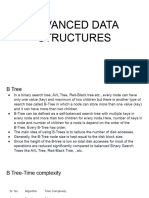Data Structures & Algorithm Lab Manual
Uploaded by
Shoaib RajperData Structures & Algorithm Lab Manual
Uploaded by
Shoaib RajperData Structures and Algorithms Practical Lab Manual
University of Sindh KBSAS Campus Naushahro Feroze Department of Information Tech
UNIVERSITY OF SINDH
KBSAS CAMPUS NAUSHAHRO FEOZE
DEPARTMENT OF INFORMATION TECHNOLOGY
PRACTICAL NOTEBOOK
Data Structures and Algorithms
Name of Student: Shoaib Ali
Roll Number: 2k23/NFIT/19
Name of Instructor: Sir Muhammad
Khalid
Roll Number: 2K23-NFIT-19 P a g e 1 | 40
Data Structures and Algorithms Practical Lab Manual
University of Sindh KBSAS Campus Naushahro Feroze Department of Information Tech
CERTIF
ICATE
This is to certify that Mr. SHOAIB ALI of 2k23 BS (IT) class bearing Roll No. 19 has
carried out the necessary Project work as per course of studies Data Structures and
Algorithms for the 2nd Year (3rd Semester) as above in practical schedule of his
journal.
Date: _____________ Course Teacher: Sir Muhammad Khalid
Roll Number: 2K23-NFIT-19 P a g e 2 | 40
Data Structures and Algorithms Practical Lab Manual
University of Sindh KBSAS Campus Naushahro Feroze Department of Information Tech
Roll Number: 2K23-NFIT-19 P a g e 3 | 40
Data Structures and Algorithms Practical Lab Manual
University of Sindh KBSAS Campus Naushahro Feroze Department of Information Tech
Table of Contents
Lab No. 1 ……………………………………………………………………………………………………………………………….
Objective: To become familiar with the downloading and installation of JDK and Net
Beans IDE 04
Lab No.2 ……………………………………………………………………………………………………………………………….
Objective: Create 0
Lab No.3 ……………………………………………………………………………………………………………………………….
Objective: Make 0
Lab No.4 ……………………………………………………………………………………………………………………………….
Objective: Create 1
Lab No.5……………………………………………………………………………………………………………………………….
Objective: Build 1
Roll Number: 2K23-NFIT-19 P a g e 4 | 40
Data Structures and Algorithms Practical Lab Manual
University of Sindh KBSAS Campus Naushahro Feroze Department of Information Tech
Lab No. 1
Objective: To become familiar with the downloading and installation of JDK and Net beans IDE.
Step 1: Open Google and type Java jdk in the search bar. Click the very first link then the new tab will
open.
Note: Internet connection is necessary to download and install java jdk.
Figure 1: Google Search Result
Step 2: Click on the highlighted option and setup will start downloading.
Figure 2: Website is opened
Roll Number: 2K23-NFIT-19 P a g e 5 | 40
Data Structures and Algorithms Practical Lab Manual
University of Sindh KBSAS Campus Naushahro Feroze Department of Information Tech
Step 3: Backup file is downloading.
Figure 4: Downloading Process
Figure 3: Downloading Process
Step 4: Here you can see that the backup of Java JDK has been downloaded, now you just have to
click on open and move to the next step.
Figure 4: Opening backup file
Roll Number: 2K23-NFIT-19 P a g e 6 | 40
Data Structures and Algorithms Practical Lab Manual
University of Sindh KBSAS Campus Naushahro Feroze Department of Information Tech
Procedure of Installation of JDK
Step 1: After opening backup, Click On Next. Step 3: The installation process begins.
Step 2: Set the destination where you want to Step 4: JDK has been installed. Now click on Close.
install the program. Click Next to continue the
process.
Roll Number: 2K23-NFIT-19 P a g e 7 | 40
Data Structures and Algorithms Practical Lab Manual
University of Sindh KBSAS Campus Naushahro Feroze Department of Information Tech
Roll Number: 2K23-NFIT-19 P a g e 8 | 40
Data Structures and Algorithms Practical Lab Manual
University of Sindh KBSAS Campus Naushahro Feroze Department of Information Tech
Procedure to make changes for running software
Step 1: Open the destination where JDK was Step 4: Go to Path Click on Edit. A dialogue
installed. box appears.
Step 2: Open bin folder. Then copy its
Step 5: Click on New to add a path.
destination location.
Step 3: Now Open System Environment
Step 6: Enter the location copied. Set a
Variables. Click on Environment Variables
name also. Click on Ok.
Option.
Roll Number: 2K23-NFIT-19 P a g e 9 | 40
Data Structures and Algorithms Practical Lab Manual
University of Sindh KBSAS Campus Naushahro Feroze Department of Information Tech
Step 7: Click on Ok.
Step 8: Check it using Command
Prompt. Check version and java
compiler.
Roll Number: 2K23-NFIT-19 P a g e 10 | 40
Data Structures and Algorithms Practical Lab Manual
University of Sindh KBSAS Campus Naushahro Feroze Department of Information Tech
Procedure of Installation of Apache Net Beans
Step 1: Open Google and type Netbeans IDE in the search bar. Click the very first link then the new
tab will open.
Figure 1: Google Search Result
Step 2: Click on the highlighted option and setup will start downloading.
Figure 2: Website is opened
Roll Number: 2K23-NFIT-19 P a g e 11 | 40
Data Structures and Algorithms Practical Lab Manual
University of Sindh KBSAS Campus Naushahro Feroze Department of Information Tech
Step 3: Click on the highlighted area.
Step 4: Click on the highlighted link the backup will start downloading.
Figure 4: Downloading Process
Roll Number: 2K23-NFIT-19 P a g e 12 | 40
Data Structures and Algorithms Practical Lab Manual
University of Sindh KBSAS Campus Naushahro Feroze Department of Information Tech
Procedure of Installation of JDK
Step 3: Set the destination where you want
Step 1: After opening backup, Click On Next. to install the program. Click on Next.
Step 2: Agree to the terms and conditions of the Step 4: Click on Next to continue the process.
software.
Roll Number: 2K23-NFIT-19 P a g e 13 | 40
Data Structures and Algorithms Practical Lab Manual
University of Sindh KBSAS Campus Naushahro Feroze Department of Information Tech
Step 5: The installation process begins.
Step 6: NetBeans has been installed. Now click
on Finish.
Roll Number: 2K23-NFIT-19 P a g e 14 | 40
Data Structures and Algorithms Practical Lab Manual
University of Sindh KBSAS Campus Naushahro Feroze Department of Information Tech
Lab No.2
Objective: Array
Definition:
Normally, an array is a collection of similar type of elements which has contiguous memory location.
Java array is an object which contains elements of a similar data type. Additionally, the elements of
an array are stored in a contiguous memory location. It is a data structure where we store similar
elements. We can store only a fixed set of elements in a Java array.
Array in Java is index-based, the first element of the array is stored at the 0th index, 2nd element is
stored on 1st index and so on.
Figure 1: Array
How an Array works?
An array in Java works by allocating a contiguous block of memory to hold a fixed number of
elements of the same data type. Here is a brief overview of how it works:
i. Array Declaration: You declare an array by specifying its type and name, along with the size
in square brackets.
Syntax:
Here, data is an array that can hold values of type double.
Here, the array can store 10 elements. We can also say that the size or length of the array is
10.
In Java, we can declare and allocate the memory of an array in one single statement. For
example,
Roll Number: 2K23-NFIT-19 P a g e 15 | 40
Data Structures and Algorithms Practical Lab Manual
University of Sindh KBSAS Campus Naushahro Feroze Department of Information Tech
ii. Array Initialization: In Java, we can initialize arrays during declaration. For example,
Syntax: at the time of declaration,
DataType[ ] arrayName = {value1, value2, value3, …};
Figure 1: Syntax
Here, we have created an array named age and initialized it with the values inside the curly
brackets.
In the Java array, each memory location is associated with a number. The number is known
as an array index. We can also initialize arrays in Java, using the index number.
Syntax (after declaration):
arrayName [index] = value;
For example,
Figure 2: Initilization using index number
Figure 3: Array Initialization
Roll Number: 2K23-NFIT-19 P a g e 16 | 40
Data Structures and Algorithms Practical Lab Manual
University of Sindh KBSAS Campus Naushahro Feroze Department of Information Tech
iii. Accessing Elements of an Array: We can access the element of an array using the index
number. Here is the syntax for accessing elements of an array,
Example: Access Array Elements
Figure 1: Code for Accessing Elements
Output:
Figure 2: Output Result
In the above example, notice that we are using the index number to access each element of
the array.
We can use loops to access all the elements of the array at once.
iv. Array Length: You can find the length of an array using the length property:
Syntax:
int length =
numbers.length;
Roll Number: 2K23-NFIT-19 P a g e 17 | 40
Data Structures and Algorithms Practical Lab Manual
University of Sindh KBSAS Campus Naushahro Feroze Department of Information Tech
v. Iterating Through Array: In Java, we can also loop through each element of the array. For
example,
Example: Using For-Loop
Figure
Output:
Using length function:
Figure 1: Syntax for Using Loop
Roll Number: 2K23-NFIT-19 P a g e 18 | 40
Data Structures and Algorithms Practical Lab Manual
University of Sindh KBSAS Campus Naushahro Feroze Department of Information Tech
Output:
Figure 2: Output Result
In the above example, we are using the for Loop in Java to iterate through each element of
the array. Notice the expression inside the loop,
age.length
Here, we are using the length property of the array to get the size of the array.
We can also use the for-each loop to iterate through the elements of an array. For example,
Roll Number: 2K23-NFIT-19 P a g e 19 | 40
Data Structures and Algorithms Practical Lab Manual
University of Sindh KBSAS Campus Naushahro Feroze Department of Information Tech
Lab No.3
Objective: Coding in Array, perform tasks using for loop
Definition:
Example: Using the for-each Loop
Task 1:
Output:
Task 2:
Output:
Roll Number: 2K23-NFIT-19 P a g e 20 | 40
Data Structures and Algorithms Practical Lab Manual
University of Sindh KBSAS Campus Naushahro Feroze Department of Information Tech
Task 3:
Output:
Task 4:
Output:
Roll Number: 2K23-NFIT-19 P a g e 21 | 40
Data Structures and Algorithms Practical Lab Manual
University of Sindh KBSAS Campus Naushahro Feroze Department of Information Tech
Lab No.4
Objective: What is a 2D Array? How it Works? Exemplify through coding.
Definition:
A two-dimensional array, also known as 2D array, is a collection of data elements arranged in a grid-
like structure with rows and columns. Each element in the array is referred to as a cell and can be
accessed by its row and column indices/indexes. A multidimensional array is an array of arrays. Each
element of a multidimensional array is an array itself.
For Example,
int [ ] [ ] a = new int [3] [4];
Here we have a created a multidimensional array named a. It is a 2D array that can hold a maximum
of 12 elements,
Roll Number: 2K23-NFIT-19 P a g e 22 | 40
Data Structures and Algorithms Practical Lab Manual
University of Sindh KBSAS Campus Naushahro Feroze Department of Information Tech
Declaration:
Syntax:
Data_type array_name [ ] [ ]; OR Data_type [ ] [ ] array_name;
Initialization:
A 2D array can be initialized during declaration.
Syntax:
dataType [ ] [ ] arrayName = { {value1, value2, value3, …},
{value1, value2, value3, …} …….};
Example:
Roll Number: 2K23-NFIT-19 P a g e 23 | 40
Data Structures and Algorithms Practical Lab Manual
University of Sindh KBSAS Campus Naushahro Feroze Department of Information Tech
In Java, we can initialize 2d arrays as following.
Roll Number: 2K23-NFIT-19 P a g e 24 | 40
Data Structures and Algorithms Practical Lab Manual
University of Sindh KBSAS Campus Naushahro Feroze Department of Information Tech
Assign Value to an Empty 2D Array:
To assign values to an empty 2D array, we can use nested loops to iterate
over the rows and columns of the array, and then assign values to each
element individually.
Syntax:
// Declare an empty 2D array
int[][] array2D = new int[rows][cols]; // rows and cols represent the number
of rows and columns in the array
// Assign values to each element using nested loops
for (int i = 0; i < rows; i++) {
for (int j = 0; j < cols; j++) {
array2D[i][j] =value ;
}
}
Example in Java:
Figure 1:
Output:
Figure 2: Output
Roll Number: 2K23-NFIT-19 P a g e 25 | 40
Data Structures and Algorithms Practical Lab Manual
University of Sindh KBSAS Campus Naushahro Feroze Department of Information Tech
Access elements of a 2D Array:
In Java, we can access elements of a 2D array using row and column indices.
Example in Java:
(By String Data Type)
Figure 1
Output:
Figure 2
Roll Number: 2K23-NFIT-19 P a g e 26 | 40
Data Structures and Algorithms Practical Lab Manual
University of Sindh KBSAS Campus Naushahro Feroze Department of Information Tech
Example in Java:
(By using Int Data Type)
Figure 1:
Output:
Figure 2:
Example in Java:
(By using Boolean Data Type)
Figure 1
Roll Number: 2K23-NFIT-19 P a g e 27 | 40
Data Structures and Algorithms Practical Lab Manual
University of Sindh KBSAS Campus Naushahro Feroze Department of Information Tech
Output:
Figure 2
Create a simple java program that represents a 2D Array
Here is a simple java program that represents a 2D Array and accesses all its elements using
nested loops:
Example:
Figure 1:
Output:
Figure 2:
Roll Number: 2K23-NFIT-19 P a g e 28 | 40
Data Structures and Algorithms Practical Lab Manual
University of Sindh KBSAS Campus Naushahro Feroze Department of Information Tech
Java Program to Initialize a 2D Array
Roll Number: 2K23-NFIT-19 P a g e 29 | 40
Data Structures and Algorithms Practical Lab Manual
University of Sindh KBSAS Campus Naushahro Feroze Department of Information Tech
Print all elements of 2d array using loop:
Output:
Roll Number: 2K23-NFIT-19 P a g e 30 | 40
Data Structures and Algorithms Practical Lab Manual
University of Sindh KBSAS Campus Naushahro Feroze Department of Information Tech
Program to add two 2D arrays:
Output:
Roll Number: 2K23-NFIT-19 P a g e 31 | 40
Data Structures and Algorithms Practical Lab Manual
University of Sindh KBSAS Campus Naushahro Feroze Department of Information Tech
Lab No.5
Objective1: Insertion Operation in an array
Insertion: Adding a new element into an array at a specific position.
Example of Array Insertion in Java
(Int Data type:)
Figure 1:
Output:
Figure 2:
Roll Number: 2K23-NFIT-19 P a g e 32 | 40
Data Structures and Algorithms Practical Lab Manual
University of Sindh KBSAS Campus Naushahro Feroze Department of Information Tech
Using String Data Type
Example:
Figure 1:
Output:
Figure 2:
Roll Number: 2K23-NFIT-19 P a g e 33 | 40
Data Structures and Algorithms Practical Lab Manual
University of Sindh KBSAS Campus Naushahro Feroze Department of Information Tech
Objective 2: Deletion Operation in Java
Array Deletion Operation:
- An array deletion operation involves removing an element from an array at a specified
position.
- This operation typically requires shifting elements to fill the gap left by the deleted
element and updating the size of the array if necessary.
Example:
Int Data Type
Figure 1:
Output:
Figure 2:
Roll Number: 2K23-NFIT-19 P a g e 34 | 40
Data Structures and Algorithms Practical Lab Manual
University of Sindh KBSAS Campus Naushahro Feroze Department of Information Tech
Roll Number: 2K23-NFIT-19 P a g e 35 | 40
Data Structures and Algorithms Practical Lab Manual
University of Sindh KBSAS Campus Naushahro Feroze Department of Information Tech
Roll Number: 2K23-NFIT-19 P a g e 36 | 40
Data Structures and Algorithms Practical Lab Manual
University of Sindh KBSAS Campus Naushahro Feroze Department of Information Tech
Roll Number: 2K23-NFIT-19 P a g e 37 | 40
Data Structures and Algorithms Practical Lab Manual
University of Sindh KBSAS Campus Naushahro Feroze Department of Information Tech
Roll Number: 2K23-NFIT-19 P a g e 38 | 40
Data Structures and Algorithms Practical Lab Manual
University of Sindh KBSAS Campus Naushahro Feroze Department of Information Tech
Roll Number: 2K23-NFIT-19 P a g e 39 | 40
Data Structures and Algorithms Practical Lab Manual
University of Sindh KBSAS Campus Naushahro Feroze Department of Information Tech
Roll Number: 2K23-NFIT-19 P a g e 40 | 40
You might also like
- Data Structure & Algorithms Lab Manual V1.2-1No ratings yetData Structure & Algorithms Lab Manual V1.2-197 pages
- Automating Essbase Data Load Through ODI - Part I100% (3)Automating Essbase Data Load Through ODI - Part I29 pages
- Data Structures Lab - Version 1.3 - Revision Summer 2023No ratings yetData Structures Lab - Version 1.3 - Revision Summer 2023104 pages
- Data Structures and Algorithms: Eng. Malek Al-LouziNo ratings yetData Structures and Algorithms: Eng. Malek Al-Louzi27 pages
- ITSE205-DataStructures and Algorithms PDFNo ratings yetITSE205-DataStructures and Algorithms PDF115 pages
- A Practical Approach To Data Structures and Algorithms-1No ratings yetA Practical Approach To Data Structures and Algorithms-1573 pages
- Data Structures Using C A Practical Approach for Beginners 1st edition by Amol Jagtap, Ajit Mali 9781000470741 1000470741 - Download the ebook now for full and detailed access100% (14)Data Structures Using C A Practical Approach for Beginners 1st edition by Amol Jagtap, Ajit Mali 9781000470741 1000470741 - Download the ebook now for full and detailed access91 pages
- Data Structures and Algorithms AssignmentNo ratings yetData Structures and Algorithms Assignment62 pages
- Data Structures Lab - Version 1.3 - Revision Summer 2023No ratings yetData Structures Lab - Version 1.3 - Revision Summer 2023158 pages
- 7BCE3C1 Data Structures and Computer AlgorithmsNo ratings yet7BCE3C1 Data Structures and Computer Algorithms137 pages
- Copy of Data Structures and Algorithms - Shubham Gupta (1)No ratings yetCopy of Data Structures and Algorithms - Shubham Gupta (1)241 pages
- [Ebooks PDF] download Data Structures and Algorithm Analysis in C 2nd Edition China Reprint Edition Weiss full chapters100% (10)[Ebooks PDF] download Data Structures and Algorithm Analysis in C 2nd Edition China Reprint Edition Weiss full chapters67 pages
- SEM1-DSA - Lesson01-Introduction to Data Structures and Algorithms (1)No ratings yetSEM1-DSA - Lesson01-Introduction to Data Structures and Algorithms (1)29 pages
- Data Structures and Algorithms With Python 100 Coding Q A Code of Code by Cakal Yasin 1100% (2)Data Structures and Algorithms With Python 100 Coding Q A Code of Code by Cakal Yasin 1327 pages
- Introduction To Data Structure and AlgorithmNo ratings yetIntroduction To Data Structure and Algorithm16 pages
- Data Structure Fundamentals MD Rafiqul Islam MD MottalibNo ratings yetData Structure Fundamentals MD Rafiqul Islam MD Mottalib167 pages
- Data Structure Fundamentals MD Rafiqul Islam MD Mottalib PDF0% (1)Data Structure Fundamentals MD Rafiqul Islam MD Mottalib PDF167 pages
- DSA M01 C01 SLM Basics of Data StructureNo ratings yetDSA M01 C01 SLM Basics of Data Structure40 pages
- DATA STRUCTURE NOTES ALL POINT HAS BEEN DISCUSSEDNo ratings yetDATA STRUCTURE NOTES ALL POINT HAS BEEN DISCUSSED18 pages
- CH # 1 (Introduction To Data Structures)No ratings yetCH # 1 (Introduction To Data Structures)16 pages
- ANSYS Workbench 2023 R2: A Tutorial Approach, 6th EditionFrom EverandANSYS Workbench 2023 R2: A Tutorial Approach, 6th EditionNo ratings yet
- Sanjeev Kumar Mishra: RF Optimization EngineerNo ratings yetSanjeev Kumar Mishra: RF Optimization Engineer5 pages
- Evaluating Readiness Degree For Industrial Internet of Things Adoption in Manufacturing Enterprises Under Interval-Valued Pythagorean Fuzzy ApproachNo ratings yetEvaluating Readiness Degree For Industrial Internet of Things Adoption in Manufacturing Enterprises Under Interval-Valued Pythagorean Fuzzy Approach32 pages
- HPC-Practical-4Addition of two large vectorsNo ratings yetHPC-Practical-4Addition of two large vectors4 pages
- Testing The Scanning Quality of Nine High-End FlatbedsNo ratings yetTesting The Scanning Quality of Nine High-End Flatbeds18 pages
- COBOL Programming Course 1 Getting StartedNo ratings yetCOBOL Programming Course 1 Getting Started46 pages
- A 'C' Test - The 0x10 Best Questions For Would-Be Embedded Programmers PDFNo ratings yetA 'C' Test - The 0x10 Best Questions For Would-Be Embedded Programmers PDF10 pages
- Lab Manual For Computer Organization and Assembly Language: StackNo ratings yetLab Manual For Computer Organization and Assembly Language: Stack8 pages
- Security Enhancement in Healthcare Cloud Using MacNo ratings yetSecurity Enhancement in Healthcare Cloud Using Mac10 pages





























































































